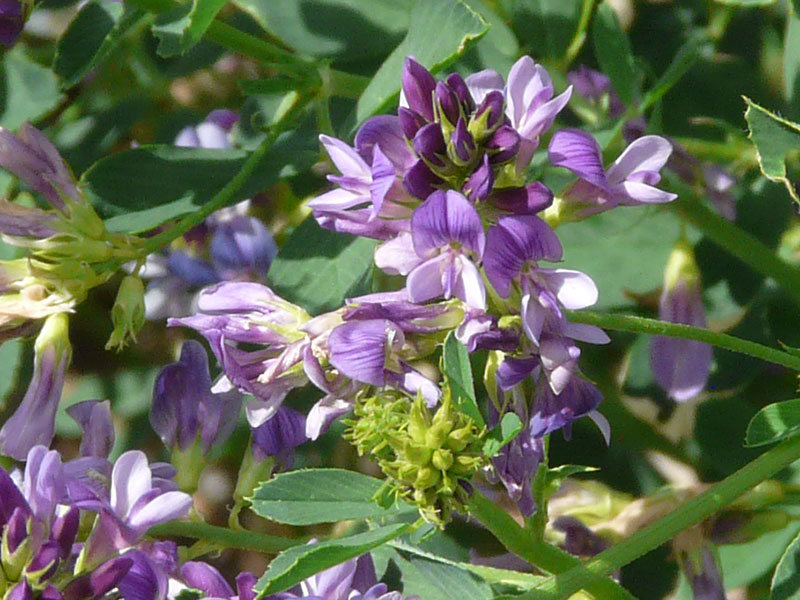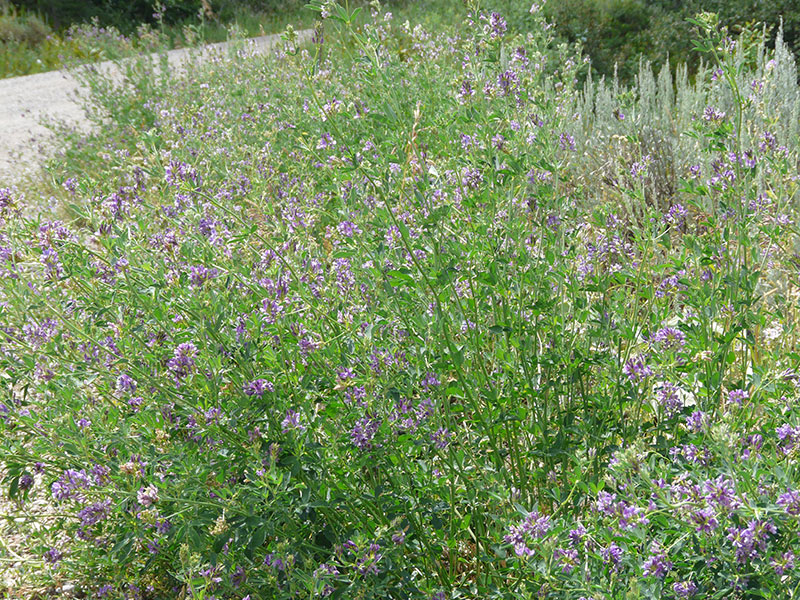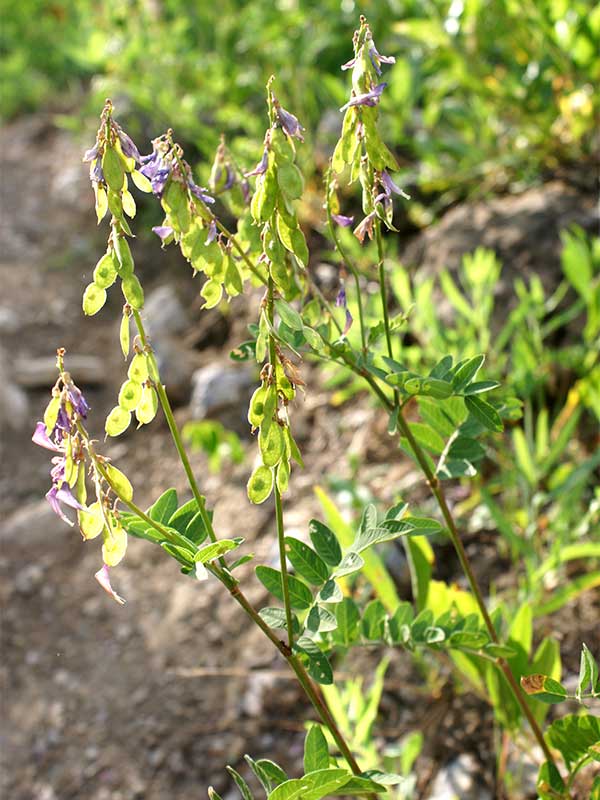Medicago sativa / alfalfa
- escaped forage plant
- bright purple flowers in dense clusters
- pea-like flowers with broad upper petal, 2 small laterals, keel
- compound leaves with 3 leaflets, the central one extended on a short stalk
- disturbed sites – roadsides, full sun
Also known as: lucerne (United Kingdom, South Africa, Australia, and New Zealand)
Alfalfa originated as a forage crop in southwestern Asia, being first cultivated in Iran. Its use was recorded in Greece in 490 BCE. It was introduced into the United States in 1736 in Georgia, but it was not until around 1850 that it began to be more widely planted. It is now naturalized worldwide due to its popularity as an agricultural species and is the most important cultivated forage in the world. After maize and soybeans, alfalfa is the third ranked crop (in dollar value production) in the United States; Idaho is one of the top three alfalfa producing states. Alfalfa is also the primary honey plant in North America.
For better or for worse, alfalfa has escaped cultivation throughout the US and Canada (and the rest of the world), probably due to seed spillage after harvesting. As a result, you are likely to run into it on your wildflower forays throughout the Valley. It is a perennial, typically living 4-8 years, but sometimes as long as 20 years.
As a bushy, somewhat woody plant, it has alternate, trifoliate leaves reminiscent of clover or the sweet clovers. The young leaves have predominantly rounded leaflets but later in maturity the leaflets are elongated.
The flowers are quite distinctive for their color – purple – and for their legume shapes. They appear in short, racemic clusters followed by yellow seed pods with 10-20 seeds. In the gallery photos, you can see both the flowers and the developing pods on the same plant.
Indeed, the seedpods are the most distinctive characteristic of the species, being brown, leathery and coiled two or three times. Other legumes lack the coiling, at least until after the pods open (e.g. the lupins). The mature pods also have coarsely toothed tips, as though they had been chopped off.
Alfalfa starts growth slowly from seed, establishing the tap root system and root crown first before concentrating on shoot growth. The seedlings of alfalfa are not very aggressive, but established plants can be very competitive. Interestingly, alfalfa demonstrates autotoxicity, meaning that its seedlings establish poorly under an existing alfalfa canopy. The caudex of older plants contains the shoot buds that enable regrowth following grazing (or mowing). Alfalfa will also tiller – send out side shoots – from the base.
Alfalfa has a very deep taproot system. This allows the plant to survive surface drought, but also to deplete the water table deeply and quickly. When first introduced to the Great Plains, for example, it depleted the water table to a 40 year level in the first season.
As a legume, alfalfa is a nitrogen fixer. This has been one reason for the popularity of this species as a crop and as a tool in restoration of particularly degraded, as by overgrazing, ecosystems. It can facilitate (re)invasion of native plants that have higher soil nitrogen requirements than what is available after degradation.
As an escaped or feral species, alfalfa prefers disturbed habitats, but unlike some non-natives, it is not a major invader of high quality natural areas. You are most likely to find it naturalized on roadsides, in old fields and in waste places. It is not shade tolerant and it does poorly at elevations above 8000 ft. In recent years, as transgenic (GMO) alfalfa has been approved for use by farmers, it has been confirmed that the trans genes have escaped into the naturalized, or feral, population in Idaho. This doesn’t seem to have made the plant more invasive.
In addition to being consumed by all classes of livestock, alfalfa is eaten by most herbivores and omnivores, including big game animals. It is eaten by some 27 species of birds and 46 species of mammals. The seeds are consumed by rodents, rabbits, upland birds, waterfowl, and songbirds. Alfalfa stands are important for brood rearing by Canada geese and nesting by gray (Hungarian) partridge.
And… alfalfa sprouts are pretty tasty as part of a salad.
| Color | |
|---|---|
| Family | |
| Blossom size | |
| Inflorescence size | |
| Inflorescence type | |
| When? | |
| Where? |



